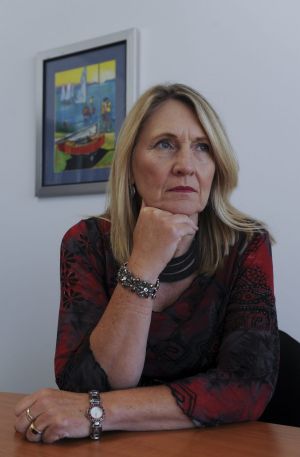
Crossroads: Directions CEO Fiona Trevelyan, pictured in her Woden office, said increased demand for drug treatment services had led to the organisation’s call for extra funding. Photo: Graham Tidy
Another Canberra drug rehabilitation service is facing financial uncertainty, despite growing demand for its services threatening to triple its waiting lists.
The head of the Directions service said an expected deficit this financial year could force it to scale back its residential detoxification and transition program, which has seen a sharp rise in calls for help from methamphetamine users.
Directions sought extra money from the ACT Government last month to avoid a $150,000 deficit this year and has had no word from the federal government on funding after June.
Chief executive Fiona Trevelyan said the residential program, run at Arcadia House at Bruce, had 30 new assessments at the start of January for clients seeking admission.
“If all of the people applying are suitable for admission, it would mean that we would be starting the year with a six-month waiting list for any other new referrals,” she said.
The waiting period for the 10-bed residential facility was now about eight weeks.
The federal government cut funding for the region’s only residential drug and alcohol rehabilitation program for families two days before Christmas.
Drug rehab provider Karralika said that may force it to close the particular service in less than two months.
Directions’ figures show 130 clients were assisted at Arcadia House in the last six months of 2014, up 19 per cent from the year before.
Of these clients, 47 per cent identified methamphetamine as a drug of concern, up from 29 per cent during the equivalent period in 2013.
The Salvation Army revealed the number of Canberrans seeking treatment from specialists after using amphetamines, including ice, increased 155 per cent in the three years to 2013.
The rate of ice use among injecting drug users in the ACT last year was almost equal to that of the two worst states on the measure, New South Wales and Victoria, with crystal meth used by 72 per cent of those Canberra drug takers.
Ms Trevelyan said the use of ice, which has proven to be linked with violence, provided extra complexity for treatment services.
“It could precipitate mental illness if there is an underlying vulnerability and it exacerbates psychosis – and makes it very difficult for service providers to understand what they’re dealing with … and to respond more appropriately,” she said.
A spokesman for Health Minister Simon Corbell said a decision was expected to be made shortly on the request for additional recurrent money.
“Arcadia House, however, is expected to be able to treat more people in their day rehabilitation program following the allocation of new funding by ACT Health this year for the purchase and installation of a demountable [building] … expected to be in place by the third quarter of this year,” he said.
The spokesman said the government would be considering the increased demand on drug treatment services within the context of the budget process.
Psychosocial interventions, rather than medication-based therapies, would continue to be the focus of therapy for methamphetamine users, he said.
“Four sessions of brief cognitive behaviour therapy intervention are offered widely in Australian treatment settings and have been shown to be effective among methamphetamine users,” the spokesman said.
Ms Trevelyan said there had not been any tender opportunity to renew the federal funding, which is worth about $700,000 annually and covers the day program and separate primary medical services.
“We’ve had no indication to think it would be cut, but we’ve got nothing for the reverse – we’re hoping it would be rolled over for at least another year,” she said.
A federal Health Department spokeswoman said funding to alcohol and drug treatment organisations beyond June 30 was still under consideration, with the findings of a review into the sector now being considered.
“While the government understands the importance of funding certainty, it is also important to make an informed decision,” she said.
Directions have said people who use amphetamine type-stimulants – which includes ecstasy, cocaine and ice – mostly range from 16 to 28 years old and tend to use a variety of substances together.
